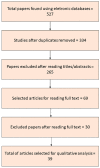Efficacy of Antimicrobial Agents in Dentifrices: A Systematic Review
- PMID: 36290071
- PMCID: PMC9598644
- DOI: 10.3390/antibiotics11101413
Efficacy of Antimicrobial Agents in Dentifrices: A Systematic Review
Abstract
The aim of this systematic review was to verify if the presence of different antimicrobial agents in dentifrices is effective in reducing the number of microorganisms for disease prevention. This review followed the Preferred Reporting Items for Systematic Review and Meta-Analysis (PRISMA) guidelines and was registered with the Open Science Framework (OSF). A search was conducted in the PubMed, Embase, Scopus, and Web of Science databases. Two independent authors reviewed the titles and abstracts according to the inclusion criteria, which comprised in vitro studies published in English that evaluated the efficacy of antimicrobial agents in dentifrices and their antimicrobial activity. A total of 527 articles were found. Of these, 334 were included for reading of the title and abstract, and 69 were selected for reading in full. In the end, 39 articles remained in this review. Triclosan, sodium fluoride, and sodium monofluorophosphate were the most commonly used chemical antimicrobial agents. Among the herbal agents, miswak extract and neem extract were the most commonly used. The presence of antimicrobial agents in dentifrice formulations can promote the reduction of the number of microorganisms involved in oral diseases, but with variations in their effectiveness, depending on the agent used and the microorganism evaluated.
Keywords: antimicrobial activity; antimicrobial agents; dentifrices; efficacy; in vitro.
Conflict of interest statement
The authors declare no conflict of interest.
Figures
References
Publication types
LinkOut - more resources
Full Text Sources




